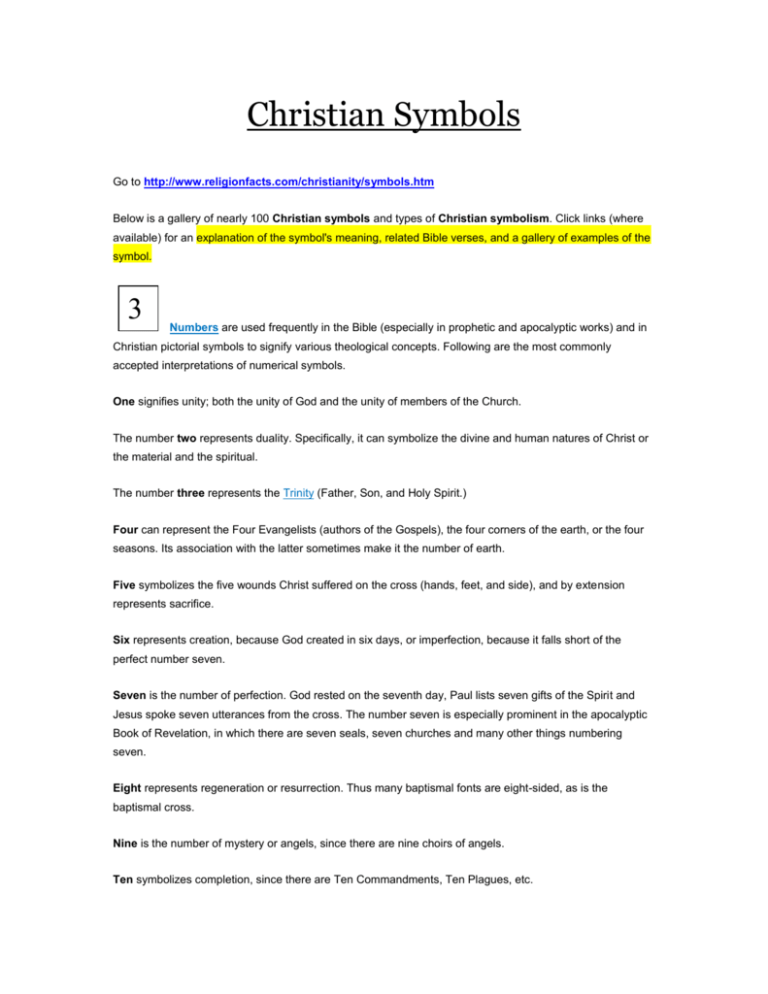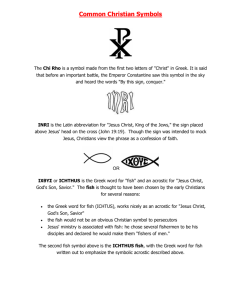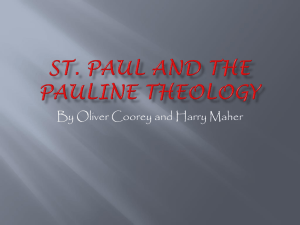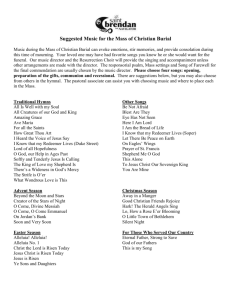Christian Symbols - First Presbyterian Church
advertisement

Christian Symbols Go to http://www.religionfacts.com/christianity/symbols.htm Below is a gallery of nearly 100 Christian symbols and types of Christian symbolism. Click links (where available) for an explanation of the symbol's meaning, related Bible verses, and a gallery of examples of the symbol. 3 Numbers are used frequently in the Bible (especially in prophetic and apocalyptic works) and in Christian pictorial symbols to signify various theological concepts. Following are the most commonly accepted interpretations of numerical symbols. One signifies unity; both the unity of God and the unity of members of the Church. The number two represents duality. Specifically, it can symbolize the divine and human natures of Christ or the material and the spiritual. The number three represents the Trinity (Father, Son, and Holy Spirit.) Four can represent the Four Evangelists (authors of the Gospels), the four corners of the earth, or the four seasons. Its association with the latter sometimes make it the number of earth. Five symbolizes the five wounds Christ suffered on the cross (hands, feet, and side), and by extension represents sacrifice. Six represents creation, because God created in six days, or imperfection, because it falls short of the perfect number seven. Seven is the number of perfection. God rested on the seventh day, Paul lists seven gifts of the Spirit and Jesus spoke seven utterances from the cross. The number seven is especially prominent in the apocalyptic Book of Revelation, in which there are seven seals, seven churches and many other things numbering seven. Eight represents regeneration or resurrection. Thus many baptismal fonts are eight-sided, as is the baptismal cross. Nine is the number of mystery or angels, since there are nine choirs of angels. Ten symbolizes completion, since there are Ten Commandments, Ten Plagues, etc. Twelve is often used to signify the whole church, since there were 12 tribes of Israel and 12 apostles. Thirteen represents betrayal since there were 13 people at the Last Supper. Forty symbolizes trial or testing, since Noah's flood, Israel's wandering in the wilderness, Moses' stay on Mt. Sinai, and Jesus' temptation in the wilderness all lasted forty days. The Lenten Season is forty days in duration for this reason. One hundred usually denotes completeness or plentitude, since it is ten times ten. One thousand represents a very large number, infinity or eternity. Colors In Christianity, color symbolism is primarily used in liturgical decorations (banners, vestments, etc.) and to a lesser degree in Christian art. Symbolic colors are rarely used in the Bible. Black is symbolic of death, and is therefore the liturgical color for Good Friday. Black can also represent sin, which results in death. Blue, the color of the sky, is symbolic of heaven. It may also be used to symbolize truth. Blue is gaining acceptance as a liturgical color for Advent. Brown is the color of spiritual death and degradation. Gray is the color of ash, so is sometimes used to represent repentance and may be used during Lent. Green is the color of plant life, abundant in spring. It is used to represent the triumph of life over death. Green is the liturgical color for the Trinity season in some traditions, and may be used during Epiphany in others. Purple is the color for penitence and mourning. It is also the color of royalty. Purple is the liturgical color for the seasons of Advent and Lent. Red is the color of blood and therefore is the liturgical color for the commemoration of martyred saints. Red is used as the liturgical color for Pentecost, since it is the color of fire. White is a symbol of purity, innocence and holiness. It is the liturgical color for the Christmas and Easter seasons. White is sometimes represented by silver. As the color of light, yellow may be used to represent divinity. However, because yellow light is not pure white, it may also be used to symbolize corruption and degradation. Greek & Latin Symbols - Latin and Greek letters, words and abbreviations are often seen in Christian art. Though not exactly symbols, they are intended to convey a particular meaning significant for Christians. Alpha and omega are the first and last letters of the Greek alphabet, signifying that Jesus is "the beginning and the end," i.e., eternal. (Rev 1:8) The Chi Rho is a symbol made from the first two letters of "Christ" in Greek. It is said that before an important battle, the Emperor Constantine saw this symbol in the sky and heard the words "By this sign, conquer." Ecce homo means "Behold the man," which was said by Pilate before Christ's crucifixion. Ecce agnus Dei is Latin for "Behold the Lamb of God." This phrase is used during Epiphany, which celebrates Christ's manifestation. INRI is the Latin abbreviation for "Jesus Christ, King of the Jews," the sign placed above Jesus' head on the cross (John 19:19) Though the sign was intended to mock Jesus, Christians view the phrase as a confession of faith. IXθYΣ or ICHTHUS is the Greek word for "fish" and an acrostic for "Jesus Christ, God's Son, Savior." See Christian Fish Symbol for more information. IHC or IHS is the first three letters of the Greek word for "Jesus" (iota, eta, sigma). Crosses The cross is one of the earliest and most widely used Christian symbol. In the most broad sense it symbolizes the religion of Christianity (and so appears at the top and left of this page). More specifically, it represents and memorializes Christ's death. A great variety of crosses has developed, some with specific symbolic meaning and others that have simply become culturally associated with certain groups. The simplest and most common cross is the Latin cross, pictured at left. It may not have come into use until the 2nd or 3rd century. The empty cross, usually favored by Protestants, reminds Christians of the resurrection, while the crucifix, with Jesus on it, favored by Catholic and Orthodox churches, is a reminder of Christ's sacrifice. The Greek cross, with arms of equal length, is the most ancient cross. The cross of Calvary or Graded Cross has three steps leading up to it, which can represent the hill of calvary or faith, hope, and love. The Celtic cross is distinguished by the circle around the cross bar and intricate designs throughout. The Russian Orthodox cross consists of three bars, the lowest bar low and slanted. The top bar represents the "INRI" sign placed over Jesus' head. The meaning of the slanted bar is not known for sure, but probably represents St. Andrew's cross (which looks like an X). St. Andrew is believed to have introduced Christianity to Russia. The crosses in the above right picture sit atop the domes of the Kremlin. Note that they have a slightly different lower bar. The papal cross is the official symbol of the papacy, and may be used only by the Pope. The three bars of the cross most likely represent the three realms of the Pope's authority: the church, the world, and heaven. The baptismal cross has eight points, symbolizing regeneration (see Numbers). It is formed by combining the Greek cross with the Greek letter chi (X), the first letter of "Christ" in Greek. The budded cross is a common form of the cross. Its trefoils represent the Trinity. The conqueror's or victor's cross is the Greek cross with the first and last letters of "Jesus" and "Christ" on top, and the Greek word for conquerer, nika, on the bottom. The lines over the top letters indicate that they are abbreviations. The triumphant cross with orb represents Christ reign over the world. It is often shown atop Christ's scepter in Christian art. An inverted cross is the cross of St. Peter, who, according to tradition, was crucified upside down because he felt unworthy to die the same way as Christ. As Catholics believe the pope to be a successor of St. Peter, the inverted cross is frequently used in connection with the papacy, such as on the papal throne and in papal tombs [photo]. It also symbolizes humility because of the story of Peter. The inverted cross has more recently been appropriated by Satanists as a symbol meant to oppose or invert Christianity. The four-pointed star symbol in Christianity is usually styled to resemble a cross. Also known as the Star of Bethlehem or natal star, this star represents both Jesus' birth and the purpose for which he was born. It is used especially for church decoration during the Advent and Christmas seasons. 5-Point Star Like the four-pointed star, the five-pointed star symbol in Christianity is also known as the Star of Bethlehem and represents Jesus' birth and incarnation. Also known as the Epiphany Star, it is used especially for church decoration during the Advent and Christmas seasons 6-Point Star The six-pointed star is the Creator's Star or Star of Creation. Its six points stand for the six days of creation, and are also represent the six attributes of God: power, wisdom, majesty, love, mercy and justice. This star is the same as the Star of David, a symbol of Judaism modern-day Israel. The six-pointed star is of ancient origin and is used in many other religions with a variety of meanings. 8-Point Star The eight-pointed star is the Star of Redemption or Regeneration and represents baptism. Eight is traditionally the number of regeneration, and thus many baptismal fonts have an octagonal base. Providing added significance is the assumption that Jesus was circumcised and named when he was eight days old (the traditional Jewish practice); baptism is seen as the New Testament equivalent of circumcision. Finally, eight persons were saved in Noah's ark, which is another Old Testament parallel of baptism. 9-Point Star The nine-pointed star symbolizes the nine fruits of the Spirit listed in the Epistle to the Galatians. "But the fruit of the Spirit is love, joy, peace, longsuffering, kindness, goodness, faithfulness, gentleness, self-control." (Galatians 5:22) This star is sometimes shown with the Latin initials for each of the fruits (charitas, gaudium, pax, longanimitas, benignitas, bonitus, fides, mansuetudo and continentia) placed within the points. The nine-pointed star is also the symbol of the Baha'i Faith. 12-Point Star A twelve-pointed star may be used to represent the twelve tribes of Israel or the twelve apostles. It may also be used at Epiphany, the twelfth day of Christmas, on which the church celebrates the manifestation of Christ as the Son of God. Alpha and Omega Alpha and omega are the first and last letters of the Greek alphabet, signifying that God is "the beginning and the end," or eternal. The symbols were used in early Christianity and appear in the Roman catacombs. In Rabbinic literature, the word emet ("truth"), composed of the first and last letters of the Hebrew alphabet, is "the seal of God," and in Judaic tradition it carries somewhat the same connotation as Alpha and Omega. The Alpha and Omega symbols are often combined with the cross, chi rho, or other Christian symbols. Agnus Dei 1 In Christian symbolism, the lamb represents Jesus, "the Lamb of God" (Agnus Dei). Standing with a banner, the lamb represents the risen Christ triumphant over death. Standing with a cross and a gash in its side, it symbolizes the passion of Christ. Agnus Dei 2 Seated on a throne or a book, the lamb represents the judgment of Christ. Because the lamb is humble, gentle, and innocent, lambs are often engraved on the tombstones of children. American Baptist Church Anchor and Fish Anchor The anchor is a very early Christian symbol that has been found in the catacombs. It brings together the cross and the various nautical Christian symbols (fish, boat, dolphin), and it symbolizes Christian hope in Christ. The anchor is also the symbol of St. Clement of Rome, who tradition says was martyred by being tied to an anchor and thrown into the sea. Apple Aureole An aureole (from Latin for "gold") is a halo that envelopes the whole body, signifying a greater degree of sanctity and divine power than a regular halo. It is also known as a mandorla (from the Italian for "almond"). The aureole or mandorla is often used for Christ in representations of the Transfiguration, Ascension and Last Judgment as well as in depictions of the Assumption of Mary and sometimes the Virgin and Child. It is especially frequent in portal sculpture on churches. Book Butterfly The butterfly has long been a Christian symbol of resurrection, for it disappears into a cocoon and appears dead, but emerges later far more beautiful and powerful than before. As a symbol of Christ's resurrection after three days in the grave, the butterfly is seen especially around Easter. But the butterfly is also a symbol of every Christian's hope of resurrection from the dead. Chalice Chi Rho (Labarum) The Chi-Rho (pronounced "KEE-roe") is a Christian symbol consisting of the intersection of the capital Greek letters Chi (Χ) and Rho (Ρ), which are the first two letters of "Christ" in Greek (ΧΡΙΣΤΟΣ, Christos). The Chi-Rho can represent either Christ or Christianity and is also known as a Christogram. The Chi-Rho is also known as the labarum, which is based on the Latin word laureum, "military standard." This is based on Constantine's application of the Chi-Rho symbol to his military standard after receiving his famous vision before the Battle of the Milvian Bridge in 312. The Chi Rho is a symbol made from the first two letters of "Christ" in Greek. It is said that before an important battle, the Emperor Constantine saw this symbol in the sky and heard the words "By this sign, conquer." The church historian Eusebius, who spoke with the emperor about his experience, described the standard: "On the top of the whole was fixed a wreath of gold and precious stones, and within this the symbol of the Saviour's name, two letters indicating the name of Christ by means of the initial letters, the letter X intersection P at the center." The Chi-Rho was used by Christians before Constantine but it became much more widespread after he adopted it. The chi-rho appeared on the coins of Constantine and his Christian successors, sometimes alone and sometimes as part of a military standard as described by Eusebius. It continues to be widely used today. Christogram Church of Scotland Church of England Crown and Cross Crown of Thorns Daisy Dogwood Dolphin Dove Doves (Seven) Easter Eggs Eagle w/ Halo Because it soars upward, the eagle is a symbol of the resurrection or ascension of Christ. By extension, the eagle symbolizes baptized Christians, who have symbolically died and risen with Christ. Especially when the eagle has a halo (as in the image above), it is the symbol of John the Evangelist. The eagle represents John because of his lofty and "soaring" gospel (it is much more theological in nature than the other three). Ecumenical Orthodox Patriarchate Episcopal Church Evangelical Lutheran Church in America (ELCA) Eye of God The Eye of God is an equilateral triangle with a single eye inside it and almost always with rays emanating from it. It symbolizes the omnipresence and omniscience of God, who watches over all things. It is also associated with the Trinity (which the triangle symbolizes in itself). Eye of God in Supper at Emmaus by Jacopo Pontormo, 1525. Uffizi, Florence. Image: WGA. Historically, representations of an eye tended to be avoided because of the association with the Evil Eye (a widespread and ancient European superstition). No medieval example of the Eye of God has yet been found. A rare Renaissance example of it appears above Christ's head in the Supper of Emmaus painted for the Carthusians in 1525 (shown above). The symbol has been connected with Masonic ritual, probably because medieval masons' guilds were often dedicated to the Holy Trinity. In the 18th and 19th centuries it was used in Courts of Justice to remind judges of their responsibilities. The Eye of God appeared above the altar of the St. Aloysius church in London, which was built by French Catholics in 1808 but destroyed in World War II. Fish The fish was an early symbol of Christian faith that endures today on bumper stickers and businesses as a sign of Christian faith. The fish is thought to have been chosen by the early Christians for several reasons: the Greek word for fish (ICHTUS), works nicely as an acrostic for "Jesus Christ, God's Son, Savior" the fish would not be an obvious Christian symbol to persecutors Jesus' ministry is associated with fish: he chose several fishermen to be his disciples and declared he would make them "fishers of men." It is said that during the persecution of the early church, a Christian meeting someone new would draw a single arc in the sand. If the other person was a Christian, he or she would complete the drawing of a fish with a second arc. If the second person was not a Christian, the ambiguity of the half-symbol would not reveal the first person as a Christian. The second fish symbol above is the ICHTHUS fish, with the Greek word for fish written out to emphasize the symbolic acrostic described above. Although the word looks like IXOYE, the letters are from the Greek alphabet, so the "I" is actually an iota, the "X" is actually a chi, the "O" is actually a theta, the "Y" is an upsilon, and the "E" or "C" at the end is a sigma. Taking the first sound from each of these Greek letter names, we get the transliteration into our alphabet of ICHTHUS. Today, when Christians (in the West) do not need to worry about persecution, the Christian fish symbol often has "Jesus" written inside or includes a cross symbol. And of course, there have been many spoofs and variations of the popular Christian symbol, such as the famous "Darwin fish" (with legs). The fish is also a symbol of baptism, since a fish is at home in the water. Fleur-de-Lis Foursquare Gospel Greek Orthodox Archdiocese of America IHS IHC or IHS is the first three letters of the Greek word for "Jesus" (iota, eta, sigma). INRI INRI is the Latin abbreviation for "Jesus Christ, King of the Jews," the sign placed above Jesus' head on the cross (John 19:19) Though the sign was intended to mock Jesus, Christians view the phrase as a confession of faith. Lilies Lutheran Church Mennonite Methodism Moravian Church of America Mormonism Nimbus Nimbus (Trinity) Olive Branch Palm Branches Papal Arms of Benedict XVI Peacock The peacock was believed by the ancients to have flesh that does not decay after death, and thus became a symbol of immortality. This symbolism was adopted into Christianity, and the peacock appears in many early Christian mosaics and paintings. Because of the way a peacock struts and displays its feathers, the peacock is sometimes a symbol of human vanity. The peacock is used in church decorations in the Easter season. Pearl Pelican According to legend, in a time of famine a mother pelican would draw blood from her own chest and give the blood to her chicks. Thus the pelican symbol in Christianity, also called pelican-in-her-piety, symbolizes the sacrifice of Christ on the cross (because he gave his blood for others) as well as the Eucharist (because it represents Christ's blood and provides spiritual nourishment). Phoenix Plumb Line Pomegranate The pomegranate is a symbol of the resurrection and the hope of eternal life. Because of its abundance of seeds, it can also symbolize royalty and the church, where the seeds represent the many believers who make up the one universal church. The pomegranate symbol derives from the ancient myth of Properspina and her annual return to earth in the spring. Christianity adopted this theme, with the pomegranate associated with the Resurrection of Christ and of believers instead of the annual resurrection of crops. The seeds bursting forth from the pomegranate are also likened to Christ bursting forth from the tomb. In Christian art, the pomegranate is often held by the Christ Child in depictions of the Madonna and Child, such as the famous example by Botticelli pictured below. Pomegranates are often used in church decorations on the Sundays after Pentecost. Poppy Presbyterian Church (USA) Go to: http://www.pcusa.org/oga/seal.htm Scales Scepter Scroll Seventh-Day Adventist Shamrock Shell Shield of the Trinity Skull Square In Christian symbolism, a square represents concepts related to the number four, such as the four corners of the earth and the Four Evangelists. In Christian art, the square is most frequently found as a nimbus (halo), where it denotes a saintly person who was still living at the time of the artwork. This is based on the identification of the number four with earth or live on earth. For more symbolism related to the number four, see Christian Number Symbolism. Southern Baptist Church Stag/Deer Trefoil Triquetra Triangle Unicorn United Church of Christ Vatican (Holy See) Winged Lion Winged Man Winged Ox








